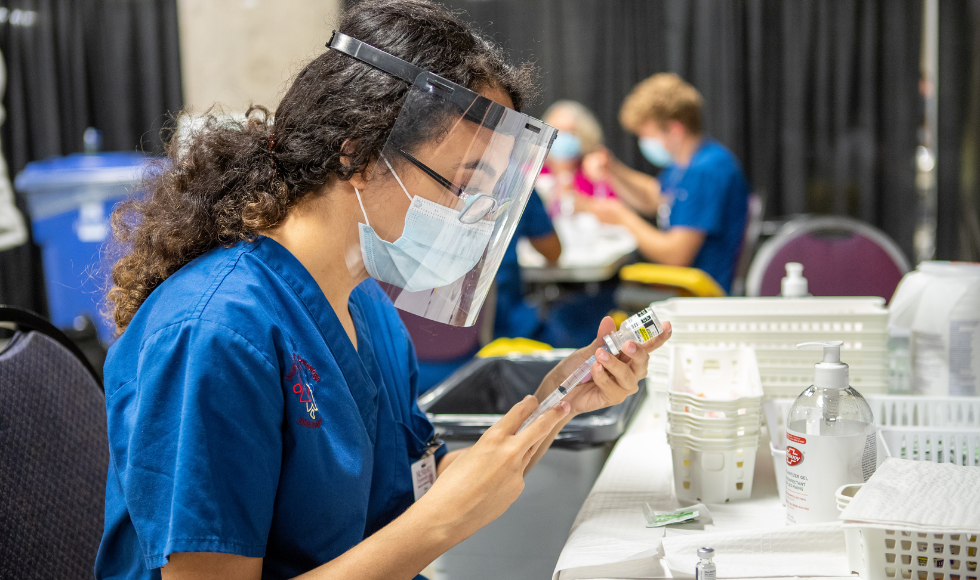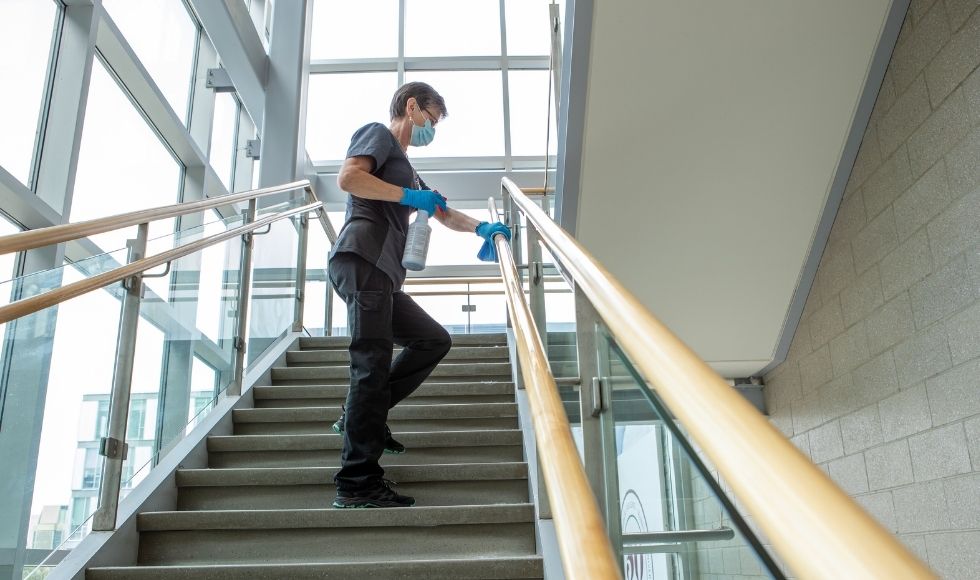Ask a McMaster expert: Answers to your COVID-19 questions
Please note: Since this article was published, the Public Health Agency of Canada (PHAC) has changed their guidelines on mask wearing. On November 12, 2021, PHAC issued this guidance: In general, while non-medical masks can help prevent the spread of COVID-19, medical masks and respirators provide better protection. No matter which type of mask you choose, proper fit is a key factor in its effectiveness.
You can read the latest on the federal agency’s COVID-19 guidance here.
McMaster University has experts contributing to the COVID-19 conversation in a wide variety of topics. Some of our experts are featured on national news media providing information on staying healthy and busting myths. Other experts are guiding our local healthcare institutions to make decisions that will provide the best care for patients and our community. Others are researching solutions in areas like masking, vaccines, clinical treatments for COVID-19, and mental health during the pandemic.
For those frequently asked questions, we have gathered the best evidence-based answers from McMaster experts, all of them leaders in their field of study or practice.
In this guide:
- Vaccination
- Screening, Testing and Staying Home When Sick
- Masks
- Cleaning
- Ventilation, distancing, being indoors vs. outside
Vaccination
 Responses in this section are provided by Matthew Miller, an associate professor in the department of biochemistry and biomedical sciences at McMaster. He is also a member of the Institute for Infectious Diseases Research and the McMaster Immunology Research Centre. Miller is also a member of the National Advisory Committee on Immunization (NACI) working group responsible for making recommendations on the use of COVID-19 vaccines in Canada.
Responses in this section are provided by Matthew Miller, an associate professor in the department of biochemistry and biomedical sciences at McMaster. He is also a member of the Institute for Infectious Diseases Research and the McMaster Immunology Research Centre. Miller is also a member of the National Advisory Committee on Immunization (NACI) working group responsible for making recommendations on the use of COVID-19 vaccines in Canada.
How important are vaccines and how could vaccines impact the pandemic?
Vaccines are the most effective way to protect against infection. High rates of vaccination reduce rates of infection, and when breakthrough infections do occur, they tend to be much less severe. Achieving high levels of vaccination will be fastest way to resume our “normal” lives
How does herd immunity work?
For various medical reasons, some individuals cannot be vaccinated, or do not mount effective immune responses to vaccines. When high levels of vaccination are achieved at the population level, those unvaccinated individuals are indirectly protected from infection by virtue of low rates of viral transmission. This is often called “herd immunity.
How do vaccines work and how well do the COVID-19 vaccines work?
Vaccines work by teaching our immune system how to recognize a pathogen (e.g. SARS-CoV-2) so that it can respond quickly if we encounter that pathogen and eliminate it before it makes us ill. The current COVID-19 vaccines are incredibly effective, and greatly reduce the risk of becoming infected with SARS-CoV-2. Importantly, they do an even better job at ensuring that people do not become severely ill.

Which COVID-19 vaccine is the best? Is it ok to mix COVID-19 vaccines?
Of the vaccines approved for use in Canada, mRNA vaccines have shown the greatest overall effectiveness at preventing infection. However, all vaccines do an excellent job at reducing risk of severe infection and death. Mixing vaccines as recommended by public health officials is not a problem. These vaccines remain safe and effective when mixed
Are COVID-19 vaccines safe?
All COVID-19 vaccines have been rigorously tested for safety in clinical trials, and careful safety monitoring has continued as the vaccines have been rolled out. As with any drug, there are small risks associated with vaccines, but for almost all individuals, the benefits of vaccination greatly outweigh the risks. If you are concerned about the safety of COVID-19 vaccines based on your medical history, you should speak with your family doctor and/or specialist for advice.
Tip: Learn about McMaster’s mandatory vaccination plan, which follows the expert advice provided above.
Screening, Testing and Staying Home When Sick
 Responses in this section are provided by Lori Burrows, interim director of the Michael G. DeGroote Institute for Infectious Diseases Research at McMaster and professor of biomedical science.
Responses in this section are provided by Lori Burrows, interim director of the Michael G. DeGroote Institute for Infectious Diseases Research at McMaster and professor of biomedical science.
What is active screening and why is it necessary before coming to campus?
Active screening involves answering a set of questions about your health status and your recent risks for COVID-19 exposure (such as close contact with sick people, travel outside of Canada). If the answers to the screen suggest that you may be at high risk for potential transmission of COVID-19 to others, even if you feel fine, you should stay away from campus. Active screening is one way to alert people to possible COVID-19 symptoms that they may not have considered suspicious.
When should I be tested for COVID-19? What kind of test should I get?
If you think you have been exposed to a person with COVID-19 or you have concerning symptoms, you should book a polymerase chain reaction (PCR) test at a registered clinic or hospital. This is the most accurate way to know if you are infected, even if you have no symptoms. If you have no symptoms and simply want reassurance that you are negative for COVID-19 (for example if you want to visit an older relative who may be vulnerable), you can take a rapid COVID-19 antigen test through a pharmacy. The rapid tests are fast but less accurate than a PCR test, and not appropriate for someone who has a known exposure to COVID-19.
Can COVID-19 spread before I show symptoms?
Yes! It can take two to five days after infection for you to show signs, and some people have mild or no symptoms at all. However, even without symptoms you can still have lots of virus in your respiratory tract, and can spread it to other people if you don’t take precautions. This is also true for vaccinated people; even though they are unlikely to become seriously ill, they can become infected and spread COVID-19, particularly the more contagious variants such as delta.
Should I stay home if I am sick?
Yes! Our best defense against COVID-19 is to stay away from other people if possible, and if you are sick, you are shedding virus. Stay home until you feel better to protect those around you.
Tip: Learn about McMaster’s requirements for screening, which follows the expert advice provided above.
Masks
 Responses in this section are provided by Catherine Clase, professor of medicine at McMaster University, who worked with an international group of researchers to examine a century’s worth of evidence and found that cloth masks, particularly those with several layers of cotton cloth, filter droplets and aerosols, which may reduce transmission of COVID-19.
Responses in this section are provided by Catherine Clase, professor of medicine at McMaster University, who worked with an international group of researchers to examine a century’s worth of evidence and found that cloth masks, particularly those with several layers of cotton cloth, filter droplets and aerosols, which may reduce transmission of COVID-19.
Why do we need to wear masks indoors? Do cloth masks even work?
Our review of research spanning over a century’s worth of evidence suggests that cloth masks can block particles, even aerosol-sized particles, and this supports Canadian public health policy on the issue. We know that cloth masks, particularly those with several layers of cotton cloth, block droplet and aerosol contamination of the environment, which may reduce transmission of COVID-19. The point is not that some particles can penetrate the mask, but that some particles are stopped. We think that this provides protection both for others and for the wearer. Epidemiologic studies from US, Germany and Canada, international comparisons, and a study of the effects of universal masking in a hospital all support reduced transmission when mask mandates are in place. Though fully vaccinated people are very unlikely to become severely ill with COVID-19, with the delta variant, they can become infected, sometimes with minimal symptoms but high viral loads and this can lead to asymptomatic transmission. Wearing masks continues to be a very important part of our strategy to reduce COVID-19 in our community and to keep each other safe.
What kind of mask is needed?
I suggest using cloth masks with two to four layers, ideally with a middle layer of non-woven polypropylene. Increasing the filtration efficiency is our goal whether we are trying to achieve source control (my mask protects you, your mask protects me) or protection of the wearer (my mask protects me). Health Canada recommends a middle layer of non-woven polypropylene in masks to improve filtration efficiency.Air that escapes or enters around the edge of the mask is completely unfiltered. You can feel these leaks when you breathe out forcefully. Use masks that fit you well: that minimize these leaks and are comfortable and stable on your face. A flexible metal strip at the nose bridge can improve fit and may also reduce glasses fogging. Sometimes we are lucky and a particular non-adjustable design will fit our face very well. Many people have favourite masks by now. However, if you are looking for new masks, consider those with adjustable earloop elastic so that you can be sure to optimize the fit.
How should I clean my mask after use?
Wash your cloth mask frequently, and at least daily, and change it as soon as it becomes damp or soiled. Cloth masks can be laundered in a washing machine, provided the fabric you have used is suitable for machine washing. If you are hand washing, use soap or detergent, increase the exposure to detergent and heat by leaving it to soak in hot soapy water for 20 minutes. Rinse the mask thoroughly before drying. Reshape masks when damp and hang to dry. With a group of epidemiologists and engineers, we have maintained a plain-language website (clothmasks.ca) with more information on mask cleaning and usage.
Tip: Learn about McMaster guidelines for face coverings and masks, which follows the expert advice provided above.
Cleaning
 Responses in this section are provided by Fiona Smaill, professor of infectious diseases and microbiology at McMaster. Smaill is a Medical Microbiologist at the Hamilton Regional Laboratory Medicine Program, which processes COVID-19 tests in our region, and a consultant in Infectious Diseases at Hamilton Health Sciences, including hospitals where COVID-19 patients are treated.
Responses in this section are provided by Fiona Smaill, professor of infectious diseases and microbiology at McMaster. Smaill is a Medical Microbiologist at the Hamilton Regional Laboratory Medicine Program, which processes COVID-19 tests in our region, and a consultant in Infectious Diseases at Hamilton Health Sciences, including hospitals where COVID-19 patients are treated.
Is cleaning surfaces important to prevent the transmission of COVID-19?
In the early days of the pandemic, when there was uncertainty about COVID-19-19 transmission, there was an aggressive approach to cleaning all surfaces, even groceries. Now, scientific evidence tells us that is very unlikely to get COVID-19 from surfaces; contact with an infected person is the usual source. Continuing to have a cleaning protocol that disinfects high-touch surfaces frequently is sensible, as is close attention to frequent handwashing and use of hand sanitizer.

When and how should I clean my hands?
Washing hands is a healthy habit and it can help prevent the spread of many infectious diseases. The best way to wash your hands is with soap and water. With wet hands, apply soap and rub hands together for at least 20 seconds. Make sure to rub your palms, back of each hand, between fingers, thumbs and under nails. If soap and water are not available, use a hand sanitizer and rub your hands together well, covering all surfaces, until dry. Wash your hands often, including after taking your mask off and putting it on. Wash your hands after going to the bathroom; before eating; after blowing your nose, coughing, or sneezing; after touching your cell phone or contact with frequently touched surfaces. Try not to touch your eyes, nose or mouth unless you have washed your hands first.
Tip: Learn about McMaster’s comprehensive cleaning plan on the Back to Mac website, which follows the expert advice provided here.
Ventilation, distancing, being indoors vs. outside
 Responses in this section are provided by Zain Chagla, an associate professor at McMaster, co-medical director of infection control at St. Joseph’s Healthcare Hamilton. During the pandemic, Chagla has contributed to government policy and planning, and conducted clinical research on COVID-19 therapies. He has been published on topics ranging from COVID-19 research, epidemiology, testing, and infection control.
Responses in this section are provided by Zain Chagla, an associate professor at McMaster, co-medical director of infection control at St. Joseph’s Healthcare Hamilton. During the pandemic, Chagla has contributed to government policy and planning, and conducted clinical research on COVID-19 therapies. He has been published on topics ranging from COVID-19 research, epidemiology, testing, and infection control.
Is COVID-19 spread through the air?
The virus is spread through respiratory particles of varying sizes, from large droplets to small aerosols. For the most part, much of the transmission is at close contact. However, in areas with poor ventilation and crowding, particles can linger in the air and spread over a further distance.
How can a building’s ventilation system help prevent COVID-19 transmission indoors?
We have all heard of COVID-19 transmission occurring at choir practice or the gym, where people are in close contact without masks breathing heavily. When people spend time together indoors without masks, in areas without proper ventilation, the risk of transmission is higher. Assessing indoor ventilation, increasing fresh air and updating filters, plays an important role in preventing the spread of COVID-19 indoors
Tip: Learn about McMaster’s enhanced outdoor spaces for gathering and collaborating, which follows the expert advice provided above.
When everyone is fully vaccinated and wearing a mask, will it still be necessary to practice physical distancing?
While vaccines are effective at preventing the spread of COVID-19, and very effective at limiting people becoming ill, they are not perfect, and there is limited spread even in vaccinated individuals, as well as a high risk of spread in those who aren’t immunized or people who have immune compromising conditions. Hence, using multiple controls such as masking and distancing indoors adds extra layers of protection to the vaccines, and allows for more interactions indoors while reducing risk to everyone.

Do plexiglass barriers work to stop COVID-19 transmission?
In some settings, where spread is predominantly through large droplets this may be of some use. However, they should not be a substitute for other controls including ventilation, masking, and vaccinations, and in some settings where ventilation is inadequate, they may make things worse.
Why is being outdoors considered safer than being indoors?
Outdoor transmission of COVID-19 not that common and tends to be associated with close contact for a prolonged amount of time with others. A study of case numbers in Ireland found that just one in every thousand confirmed COVID-19 cases was traced to outdoor transmission. Population wide, that means 0.1 per cent of total cases was linked to outdoor transmission. It’s still important to mask in very crowded settings outdoors, and distance, but even in that context, we still see very little transmission.
Tip: Learn about McMaster’s ventilation plan, which follows the expert advice provided above.
Back to Mac Updates, Faculty and staff, Health, Students

